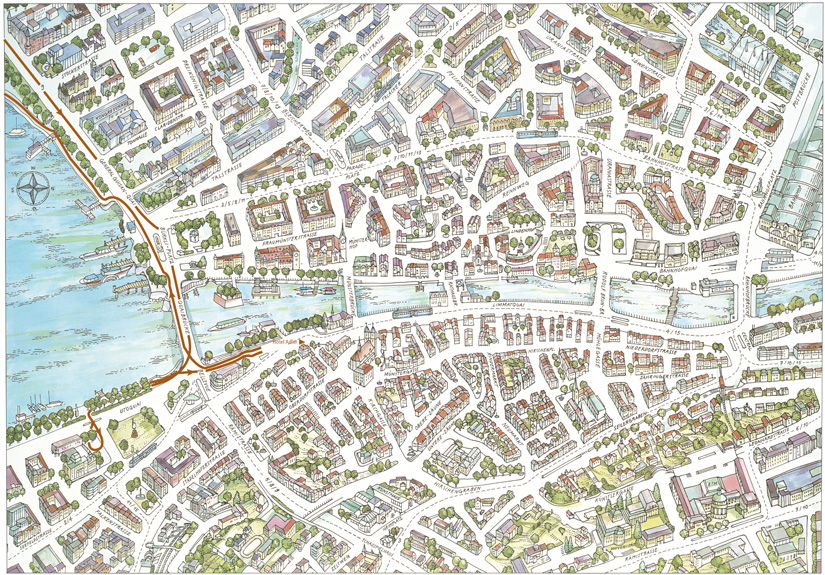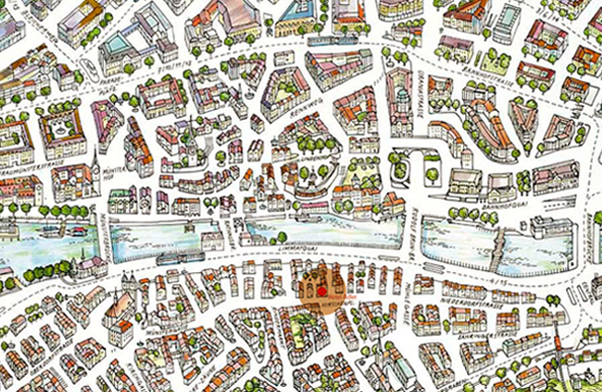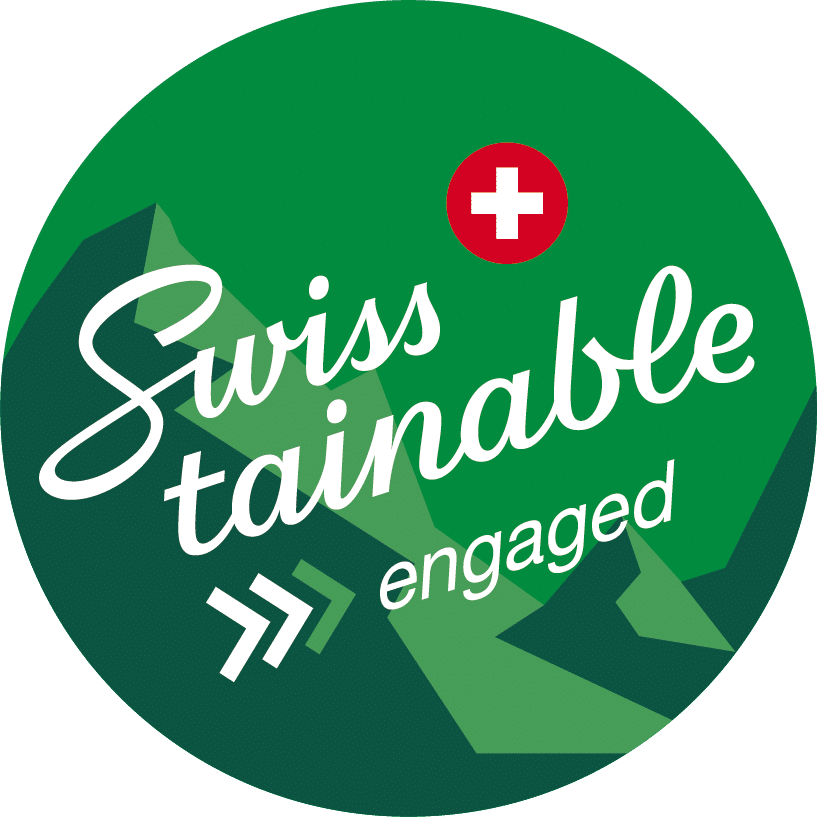Tour 6
Rundgang in den Quaianlagen am See: Limmatquai – Quaibrücke – General Guisan-Quai – Arboretum – Bürkliplatz – Quaibrücke – Bellevue – Sechseläutenwiese – Opernhaus – Utoquai – Limmatquai
Map City Tour 6
Details: Tour 6
As people look southward from the Münsterbrücke or the Quaibrücke, they are often struck by the magnificent view of the snowcapped Alps. The mountain panorama is in fact a reminder of how close Zurich is to the Alpine region. Because of the impressive view of the Alps, the numerous excursion destinations in the vicinity of Zurich are sometimes overlooked. The Albis mountain chain, for example, which is depicted in one of the “Adler“ pictures, is an ideal destination for an outing.
The Albis mountain chain and the Üetliberg

The Üetliberg is the highest part of the Albis mountain chain, which, incidentally, consists entirely of conglomerate, a sedimentary rock. Already in the 19th century a hotel and observation tower were built on the Uto-Kulm, the peak of the Üetliberg, which the townspeople affectionately call their “Hausberg“ (the House Mountain). Archaeological finds on the mountain have revealed the existence of former defensive structures. The Üetliberg offers visitors a superb panoramic view of Zurich, the Limmat and its valley, the Sihl, the lake, the plains of the canton of Aargau, the Jura mountains, the valley of the Reuss and the Alps.
The lakeside area
If time is too short for an excursion to Zurich’s surrounding area, a walk along the lakefront provides some compensation. The lakeshore area was opened to the public in 1887. The large new roads along the lakeshores transformed the former river town into a lake town and also represented Zurich’s main tourist attraction at that time.
In 1863, the canton government decided that the lake’s shoreline should be advanced and accordingly fixed new limits. This decision constituted the legal basis for reclaiming land along the lakeshore. Since the boom in railway construction coincided with this project, the railway engineers saw a unique opportunity to build the lines planned for the right and left shores, where necessary, on the reclaimed land. The plan was for the railway on the right side of the lake to go to Enge station via a bridge located in the area of Bellevue, roughly where the Quaibrücke stands today, and then to continue from Enge station to the Hauptbahnhof (the Main Station). The townspeople quickly recognised that this would jeopardize the development of the town, especially around the lakeshore, and they vehemently opposed the project, which they named “eiserner Ring“ (iron ring). Under the direction of city engineer Arnold Bürkli-Ziegler (1833–1894), a new plan was prepared which proposed a different route for the railway, involving the building of a tunnel. Bürkli also developed a project which featured the construction of roads along the lakeshore, a large square by the lake (Bürkliplatz with Bürkliterasse) and a bridge across the Limmat (Quaibrücke). Neither of these new projects was given much attention by the authorities, and therefore a protest meeting was organised, at which between 1500 and 2000 people participated. The citizens’ protest proved successful since, only a few weeks later, contracts in accordance with Bürkli’s plans were signed with the private railway company. In 1878, the final project for the construction of the new lakeside area was ready, and it was put to a vote in 1881. Within the city, the project was accepted by a massive majority, and the two municipalities Riesbach and Enge, which were also involved in the project, even accepted it unanimously. The technical direction of the building process was entrusted to Bürkli, and construction began a year after the vote.
During a six-year construction period, 200 000 m2 of land was reclaimed from the lake, and more than 1 200 000 m3 of stone and mud were deposited in the lake to create the new shoreline. The area around the lakeshore changed from one day to the next. Idyllic natural areas as well as unattractive workshops and storage spaces all disappeared, and numerous houses that had stood directly on the shore rapidly found themselves in new surroundings at quite a distance from the lake. Reclaiming the land was achieved in several stages. First, pool-like enclosures were built of stones. The water was then pumped from these pools, and they were finally filled with marl, a lake sediment composed of mud, clay and limestone, which was brought to the landfill by boat. The landfill was then left to dry out naturally, a process taking many months. As the land was reclaimed, other construction work went ahead. Two quays were built, and in the Enge district a magnificent arboretum was laid out. On July 2 and 3, 1887, the opening of the new lakeshore was celebrated with a public festival. One of this festival’s most memorable events was a procession of 6000 schoolchildren from the surrounding municipalities, who were dressed in traditional costumes. At the end of the 19th century, yet more land was reclaimed from the lake. The lakeside area was enlarged in Riesbach, as far as the Zürichhorn, and on the other side of the lake, in Enge, as far as the Belvoir estate. In the 20th century, the lakeshore again saw construction work, especially some changes to the original layout. In honour of Bürkli, who had not just designed the whole project but had fought for it and had finally carried it out, a memorial was erected in his favourite place, the arboretum.
Along the newly opened lakeshore, many large, attractive residential buildings and villas were constructed. Although most of these villas had to make room for more profitable office buildings after the Second World War, the majority of the bourgeois “fin de siècle“ residential buildings survived, for example the “Rote Schloss“ (red castle) at General Guisan-Quai no. 20–22, built between 1891–1893, the “Weisse Schloss“ (white castle) at General Guisan-Quai no. 30–36, erected between 1890–1892, and the “Utoschloss“ at Utoquai no. 29–31, built in 1898. The land adjacent to the new lakeshore offered ideal sites for the construction of the Tonhalle (the Concert Hall), located at Claridenstrasse no. 7, and a theatre, which today serves as the “Opernhaus“ (the Opera House).
The Opernhaus

Wealthy friends of the theatre succeeded in raising sufficient funds for a new theatre in a very short time. The town council in turn made one of the most attractive sites near the newly created lakeshore available for the construction of the new theatre. The contemporary experts of theatre architecture Fellner and Helmer of Vienna were consulted about the construction of the theatre. Owing to lack of time, it was decided to use the plans that these architects had previously drawn up for the theatre in Crakow, Poland. The plans, for which Fellner and Helmer had won first prize in a competition, had not been used because the people of Krakow had decided to favour a local architect instead.
The new Zurich theatre was built in only 16 months. Since the theatre was to be erected on reclaimed land, approximately 2000 oak piles were driven into the ground to create a base for the stone foundations. The theatre’s interior was decorated by local artists as well as by numerous artists from Vienna. On September 30, 1891, the new theatre was inaugurated, and on the following day, a performance of Richard Wagner’s “Lohengrin“ was given.
The well-proportioned facade of the theatre, today’s Opernhaus, with its striking portico, faces the Sechseläutenplatz (Sechseläuten square) and the town centre. Since the last century, the “Böögg“ (a snowman symbolizing winter) has been burnt each year on the Sechseläutenplatz. The burning of the “Böögg“ on an enormous pile of wood is an integral part of the yearly spring festival of “Sechseläuten“ and takes place after the historic guild procession (see page 53).
Reviews
Barry S
Google, 19.8.23
Very nice boutique Hotel. Convent to the main station and tram 4 . Maybe a ten minute walk . ( we walked upon arrival ) In a nice area of old town with many shops and restaurants steps away . Easy check in . They have complimentary water and drinks . Museum access that we took advantage of . Our room was on the top floor with a balcony . Would not consider staying anywhere else .
Sarah B
TripAdvisor, 19.8.2023
Nice location, even better people!
Anne Clarisse V
Google, 5.9.2023
Spent my birthday here and it was lovely. The fondue and raclette tasted amazing! And the staff was very friendly. They also sang happy birthday and brought out an ice cream dessert with a sparkler.
David S
TripAdvisor, 2.9.2023
Cheese fondue heaven.
Our Location
Hotel Adler Zürich
Rosengasse 10
CH-8001 Zurich
+41 44 266 96 96
info@hotel-adler.ch
Our front desk is available 24/7
Reviews
Our Partners
© Hotel Adler Zürich | Imprint | Terms & Conditions | Privacy | Voucher | Covid-19











